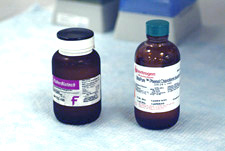Archival Notice
This is an archive page that is no longer being updated. It may contain outdated information and links may no longer function as originally intended.
Home | Glossary | Resources | Help | Contact Us | Course Map
Chelex® 100 extraction methods are straightforward, with little variation between procedures. Some examples are:
- Laboratories may differ with respect to their inclusion of Proteinase K, a serine protease that aids in protein digestion.
- For extraction from blood, the sample may be incubated in sterile deionized water that promotes hemolysis of red blood cells. This aids in the removal of heme, a known PCR inhibitor.
- Some laboratories wash the sample in phosphate buffered saline prior to extraction. The sample may be washed one or more times and pelleted through centrifugation before resuspending it to carry out the Chelex® 100 extraction procedure.
Additional Online Courses
- What Every First Responding Officer Should Know About DNA Evidence
- Collecting DNA Evidence at Property Crime Scenes
- DNA – A Prosecutor’s Practice Notebook
- Crime Scene and DNA Basics
- Laboratory Safety Programs
- DNA Amplification
- Population Genetics and Statistics
- Non-STR DNA Markers: SNPs, Y-STRs, LCN and mtDNA
- Firearms Examiner Training
- Forensic DNA Education for Law Enforcement Decisionmakers
- What Every Investigator and Evidence Technician Should Know About DNA Evidence
- Principles of Forensic DNA for Officers of the Court
- Law 101: Legal Guide for the Forensic Expert
- Laboratory Orientation and Testing of Body Fluids and Tissues
- DNA Extraction and Quantitation
- STR Data Analysis and Interpretation
- Communication Skills, Report Writing, and Courtroom Testimony
- Español for Law Enforcement
- Amplified DNA Product Separation for Forensic Analysts


